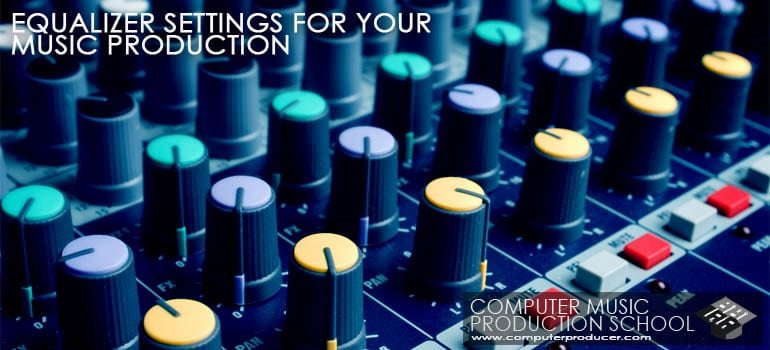When thinking of EQ settings, many students are unsure of where to start. I am often asked “how do I EQ this instrument?” or “what are the rules of Equalization for drums and bass?” If you are using an MPC, Triton, Motif, or any other hardware gear, these guidelines can apply but are best left to the final mix stage in your Software Sequencer (Cubase, Sonar, Logic, ProTools, etc).

The most important aspect of music production equalizer settings & mixing is the low shelving or hi pass filter function. These functions are used for cutting frequencies and are included as standard features in the majority of Equalizers. When an element in the mix is left untouched, it may contain unheard frequencies that can interfere with the punch, clarity, loudness and energy of the mix.
The solution is cutting. The goal is to remove unneeded frequencies to create additional space for the elements in the mix. For example, the frequencies below 100Hz on a snare drum may interfere with a sub bass or kick drum.
As a guideline, I recommend cutting all instruments at 100Hz and cutting the bass instrument and kick drum at 30-40Hz. The human ear cannot hear anything below 30Hz-40Hz. This will remove bass frequencies from the entire mix that are not heard but take up energy in the mix. This ‘energy’ takes away from your overall headroom meaning it makes the overall track louder than it really is. By removing these frequencies on each individual instrument your overall mix becomes louder and punchier. In result, you’ll achieve a better mix and master.
 Applying EQ less is always more. Boosting frequencies should be used as a last resort. For example, if a high hat doesn’t have enough high end, boost the appropriate frequency needed. However, if you have 2 instruments in that same frequency, you should boost one and cut the other to avoid interference. If you tend to boost frequencies often, you may need to choose higher quality sounds.
Applying EQ less is always more. Boosting frequencies should be used as a last resort. For example, if a high hat doesn’t have enough high end, boost the appropriate frequency needed. However, if you have 2 instruments in that same frequency, you should boost one and cut the other to avoid interference. If you tend to boost frequencies often, you may need to choose higher quality sounds.
Another great use for EQ is to find the ‘sweet spot’ of a sound. Boost the EQ to the maximum decibel and sweep the entire frequency band from the lowest to highest until you find the ‘sweet spot’. This is a useful way of finding the frequency range your instrument is in. From there you can choose how much to cut while listening to the mix. For example, if you have a bassy string or synth part that interferes with the bottom end, you may want to cut it at 300hz or more. Cutting low frequencies off vocals is the biggest EQ tip of all. Try cutting vocals at 300hz for a low voice or 500hz for a high female voice. You’ll be amazed at how they fit in the mix.
 Cubase, Nuendo, Sonar all have eq on every channel. ProTools does not. This can be a problem for ProTools users as EQ is used as a plugin which takes valuable CPU usage. I have found mixing in ProTools can take additional time from that fact alone. However, you can create buss or group channels to lower the amount of CPU usage.
Cubase, Nuendo, Sonar all have eq on every channel. ProTools does not. This can be a problem for ProTools users as EQ is used as a plugin which takes valuable CPU usage. I have found mixing in ProTools can take additional time from that fact alone. However, you can create buss or group channels to lower the amount of CPU usage.
Overall, EQ is one of the most powerful tools when mixing. There is no such thing as a ‘one size fits all’ solution. Unlocking EQ consists of applying it to one instrument at a time and practicing. Soon you’ll develop your own technique and approach that will help nail the mix every time.
Now, apply these EQ settings in a music production you are currently working on to hear the instant results of this tutorial. This is just a small dose of instant results you’ll get when enrolling in the 7 Lesson Course: Becoming a Music Producer and Audio Engineer.
Tutorial: EQ Settings; Music Production Equalizer Settings
1) Start with a sub bass kick drum. Cut using a low shelf or hi pass setting at 30hz, then 50hz, then 80hz and finally 120hz. Use this as an ear training exercise until your ears can clearly hear the difference.
2) Now take a punchy bass line (not a sub bass) and follow the same guidelines as #1. Pay attention to how the sub bass kick drum and punchy bass line fit like a glove by only cutting frequencies. Remember, when learning eq NEVER boost – you’ll do more harm than good. If you feel the need to boost, you are better off finding a better sound that has the settings you’re looking for.
3) Experiment with vocals. Cut in the 300hz range for male vocals and 500hz range for female vocals. Again, use this as ear training and start to hear how each instrument fits ‘in the pocket’ by cutting vs. boosting.
If you need more info on EQ, recording and mixing, setup a free training consultation below.


rami
October 13, 2014 at 2:26 pmgreat guide line starting point !!!
Thanks